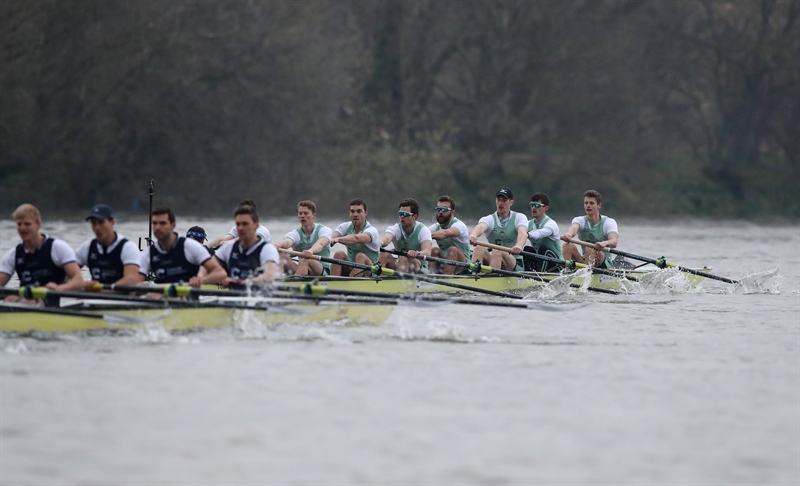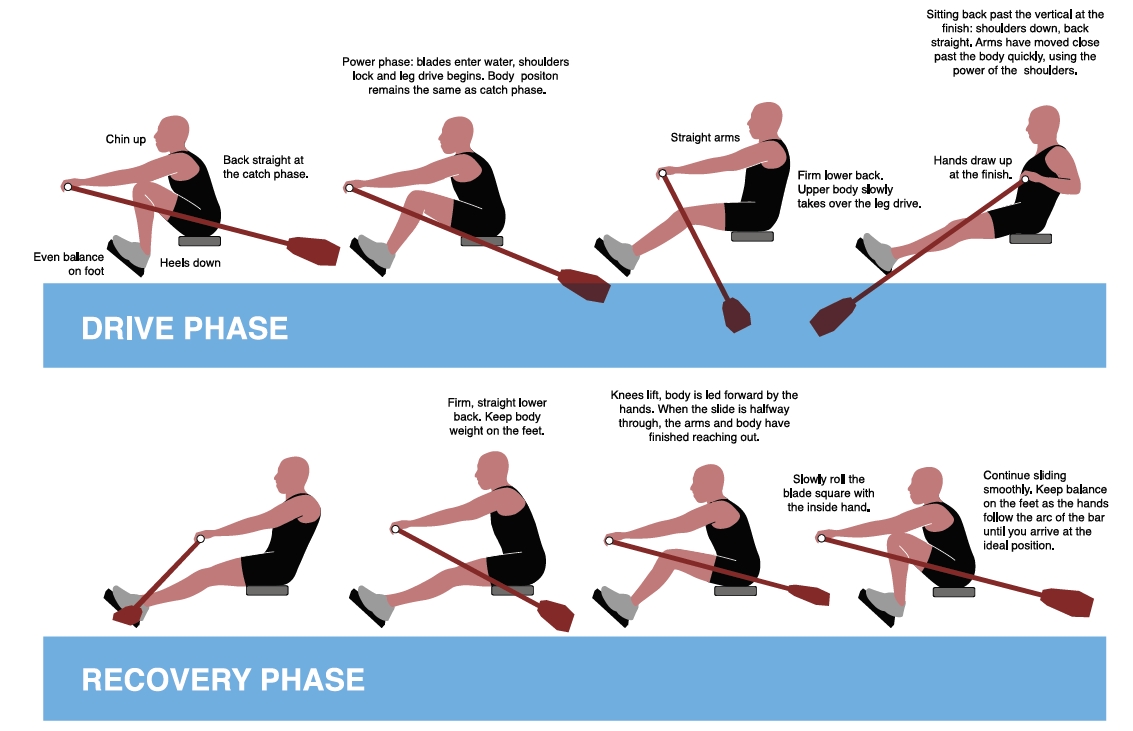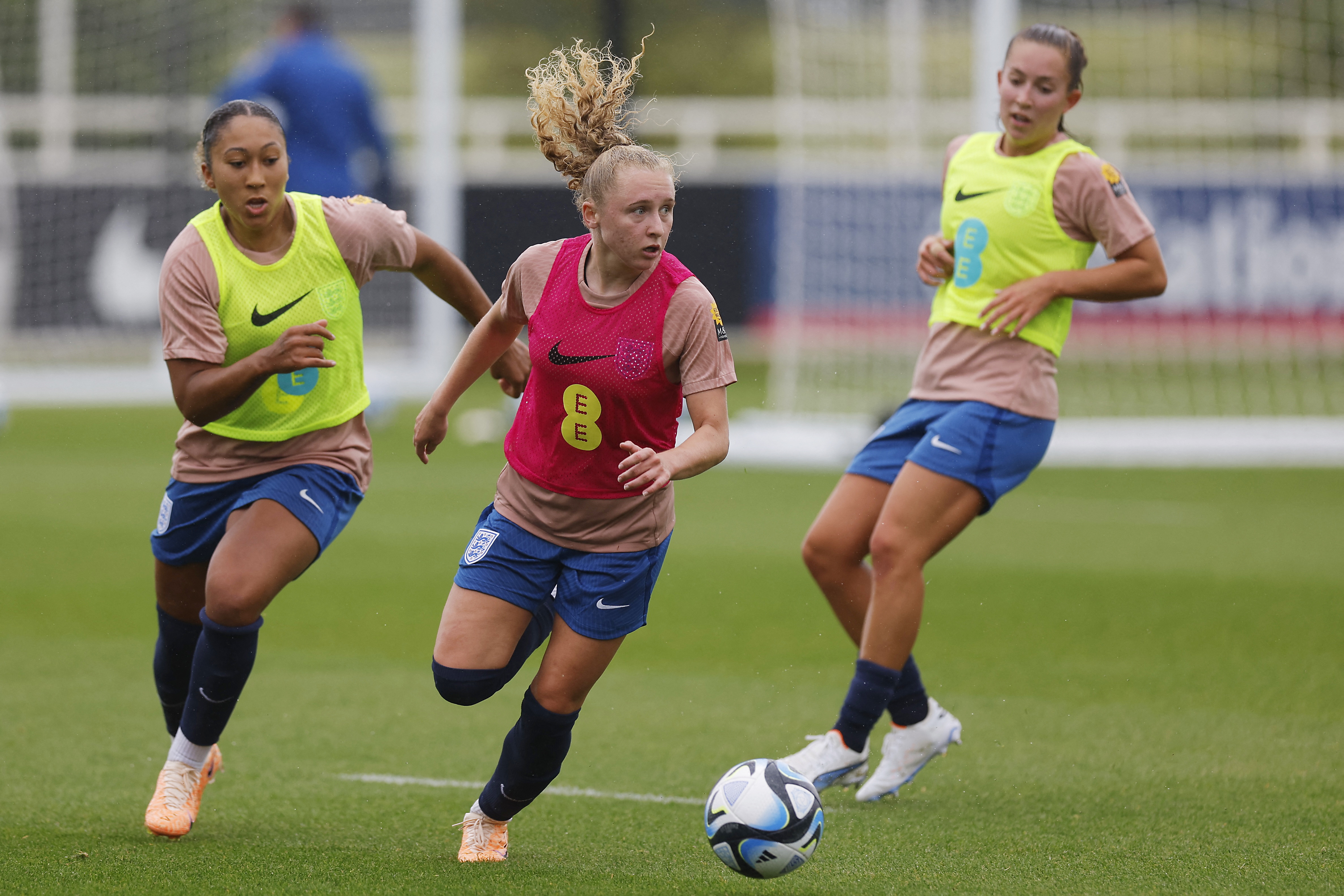You are viewing 1 of your 1 free articles
Low Back Pain: Anything but a Dream for Rowers
Rowers of all abilities are prone to lower-back injury. With this in mind, Alicia Filey shows how attention to technique and training can mitigate some of the risk factors, enabling athletes to enjoy rowing throughout their lives.
Oxford University vs Cambridge University Boat Race - London, Britain - 2018
Rowing has been a competitive sport since the early 1800s, and was one of the first sports included in the modern Olympics. The sport of rowing falls into two basic categories, sculling and sweep rowing. When sculling, each person mans a set of oars; therefore, singles may row as well as doubles and quads. In sweep rowing, however, each person in the boat mans only one oar, so sweep boats by necessity require paired athletes to compete.
Row, Row, Row Your Boat
Regardless of the type of rowing, the oarsman sits in the boat facing the stern, while the bow of the boat is the first part to cross the finish line. Their feet are anchored in shoes attached to a fixed footboard or stretcher.
The stroke, performed repeatedly exactly the same way from start to finish, is divided into the drive and the recovery phases (see figure 1). The drive begins at the catch, the moment when the oar is placed into the water. The ankles, knees, and hips of the rower are flexed; the back is forward, preserving the natural arch in the low back (not rounding); the pelvis is tilted forward; the shoulders are flexed; and the elbows are straight.
The rowing stroke begins at the catch where the body is flexed like a compressed spring, full of potential energy. The back is straight and the forward reach comes from shoulder and hip flexion. As the drive commences, the trunk posture remains the same, with the back straight and strong. At the end of the drive the trunk is extended from the hips, but the back is still straight and stabilised in the extended position through the eccentric control of the abdominals and hip flexors. The recovery is almost entirely passive; the back remains straight and the forward flexion comes from the hips. Adapted from www.mcshane.org/coxes/technique.gif and www.rowperfect.co.uk and used with permission.
As soon as the blade of the oar is in the water, the rower drives the legs into extension using the rectus femoris to initiate the movement. The trunk remains straight but forward, flexed about 30° at the hips, and braced in this position by the thoracic and lumbar paraspinal muscles. The shoulders stay flexed and the elbows extended, with the trapezius, serratus anterior, deltoid, and teres major muscles actively engaged. By staying in this position, the back, shoulders and arms transmit the force from the legs directly to the oar without a loss of power(1).
As the drive progresses the legs extend using the gastroc/soleus, quadriceps and gluteal muscles (assisted by the hamstrings acting as hip extensors), and push the rower’s seat back. At mid-drive the lumbar spine experiences added amounts of sheer and compressive forces as peak acceleration forces are transmitted from the legs to the oar. The paraspinals, latissimus dorsi, serratus anterior and deltoid muscles contract maximally to prevent injury to the spine and provide stability at the shoulders during a time when the force transmitted from the legs is at its greatest.
As the rower nears the end of the drive phase (called the finish) the legs are almost fully extended and braced against the footplate by the active quadriceps. The trapezius and the latissimus dorsi, along with the rectus and external oblique muscles, stabilise the spine, now extended 30° at the hips, while the posterior deltoids, biceps, brachioradialis, and pectoralis muscles draw the oar in close to the body and the flexor carpi ulnaris flexes to bring the oar toward the navel.
At the finish, the rower depresses the oar handle enough to draw the blade out of the water and pushes the oar away from the body. When the blade is out of the water, the rower uses the hand closest to the blade (in sweep rowing) to feather the blade.
During the recovery, the rower’s trunk leans forward from the hips and the legs flex until the rower returns to the catch position. Much of the recovery phase is passive, with little to no activity of the paraspinal muscles. The hamstrings become more active toward the end of the recovery phase as they draw the body into the catch position. The latissimus dorsi also activates more strongly just prior to the catch, and the paraspinals fire as they ready for the stability needed at the catch.
Powerfully Down the Stream: Biomechanics of Spinal Loading
Low back injuries account for 15-25% of all rowing injuries(2). It is no wonder when one considers the strain placed on the spine during rowing. A study conducted at the University of Melbourne evaluated the lumbar spines of 14 female rowers and 14 age-matched control subjects. The study found that the L4/L5 joint endured the greatest shear and compressive forces during ergometer rowing. The peak compressive force while rowing was found to be 4.6 times the body weight of the rower(3). In sweep rowing, the compressive and sheer forces are compounded by the rotational and lateral bending stress of using only one oar.
If the spine consisted of the skeletal structure alone, it would collapse under a load as little as four to five pounds(4). How, then, are rowers able to withstand forces of at least 4.6 times their body weight? When moving a load, the spine acts as a cantilever that pivots at the hips (see figure 2). In rowing, the same concept applies as the force from the legs is transmitted through the spine and exerted upon the water through the oar. The only thing offsetting the weight of the trunk and the load to be moved is the force generated by the back and hip extensors. However, some researchers calculate that the resistance from the hip and trunk muscles is insufficient to overcome the damaging reaction force created at the lumbar spine, and other systems must help to prevent injury(4). Other systems must assist the spine to safely carry the load.
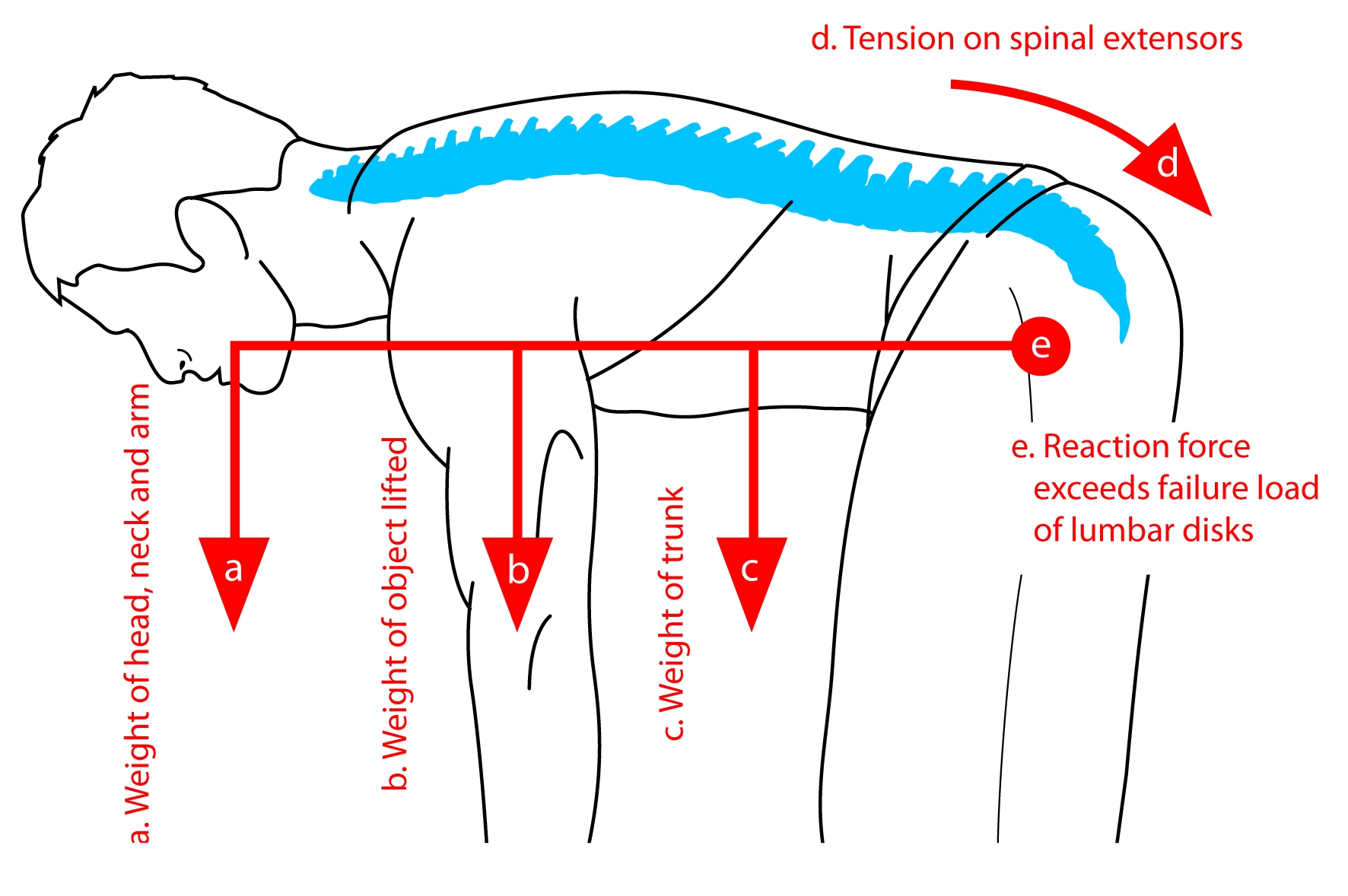 Figure 2: The spine as a cantilever
Figure 2: The spine as a cantilever
In addition to the muscles of the back and hips, the spine is supported by a web of ligamentous and fascial connections. These passive structures consist of tough connective tissue that places a stabilizing tension on the spine, like a pre-stressed beam. Along with the tension of the back muscles, they provide significant support to the spine(4).
One of these passive structures is the thoracolumbar fascia (TLF) (see figure 3). The TLF consists of three layers of fascia that cover the entire thoracic and lumbar area of the back. This fascia wraps around the side to connect with the tendons of the transverse abdominis, oblique, and latissimus dorsi muscles. When these muscles contract, they pull on the TLF, causing it to stiffen, which approximates and stabilizes the vertebra.
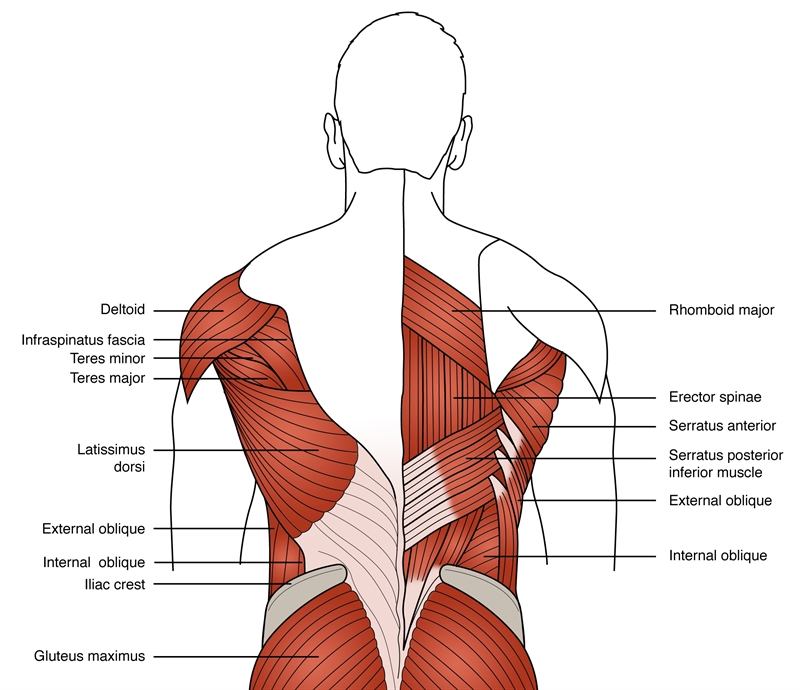 Figure 3: Anatomy of the primary low back muscles used in rowing
Figure 3: Anatomy of the primary low back muscles used in rowing
The posterior layer of the TLF is visible. Note its attachment to the vertebrae as well as the pelvis and latissimus dorsi. The erector spinae muscle lies between the middle and anterior layer of the TLF.
Notice that the TLF has a middle and posterior layer surrounding the erector spinae muscles, the longissimus and the illiocostalis. When these muscles contract to extend the spine and pull against a load, as in the drive phase, they push against the non-contractile TLF. This leads to a build-up of fascial tension that allows the TLF to act as a hydraulic amplifier for the erector spinae muscles, amplifying their force by as much as 30%(4).
While the erector spinae muscles function to extend and stabilize the spine, their endurance, rather than overall strength, prevents injury(4). Fatigue in these muscles causes a reduction in the precision and control of trunk movements. Fatigue also causes the rower to adopt a more flexed posture, especially at the catch, exposing the intervertebral discs to injury (see figure 4).
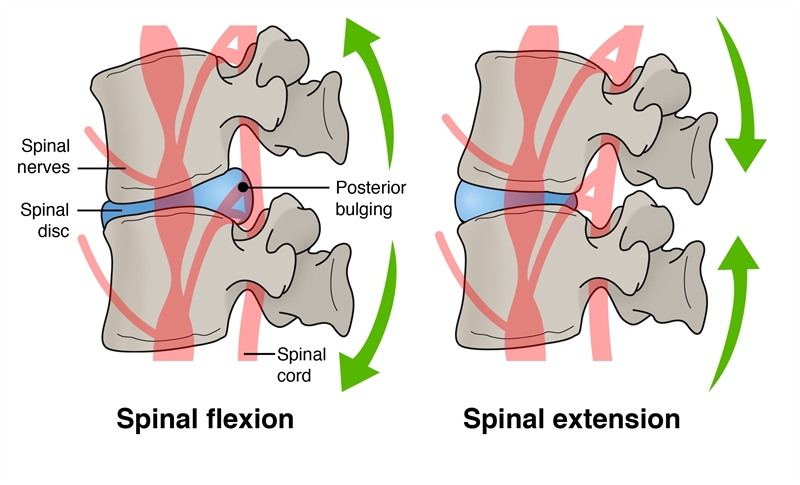 Figure 4: Spinal discs and injury susceptibility
Figure 4: Spinal discs and injury susceptibility
Researchers in Brazil evaluated 22 asymptomatic adolescent male rowers and 22 age-matched controls that did not participate in regular physical activity. MRI scans of the lumbar spines of all boys revealed 31.8% of the boys who rowed had disc abnormalities in their lumbar spines, whereas only 13.6% of the control group demonstrated such changes.
An increase in intra abdominal pressure (IAP) also assists the extensor mechanisms in bearing the load placed on the spine. The diaphragm, abdomen and pelvic floor muscles, when contracted together, contribute to an increase in IAP as when bracing for a blow to the gut. The muscles set the rib cage and compress the visceral contents, providing an extensor moment to the spine.
Increasing the IAP makes the trunk a more solid cylinder, which both reduces the sheer and compressive forces placed upon the spine, and increases the area that bears the load(4). The transversus abdominis, the deepest abdominal muscle, shows increased activation in maximum isometric trunk extension and consistently shows the most activity with increases in intra-abdominal pressure (IAP), verifying its importance in stabilizing the lumbar spine(4).
At Northern Illinois University, scientists compared the intra-abdominal pressure (IAP) in ten volunteers while inspiring and expiring during the drive phase of the stroke(5). They found that expiring during the drive elevates the IAP, which may offset the other forces imposed on the spine. Inhaling during the recovery phase means that expiration can begin at the catch when forces are strong and peak during mid-drive as the compressive and shear forces do.
Tightness in the hamstrings and gluteal muscles also contributes to increased flexion at the catch. Rowers may compensate at the spine for a lack of flexibility in the hips and legs, placing greater flexion strain on the paraspinals and again, leaving the discs vulnerable. Researchers at the Medical College of Virginia evaluated the strength and flexibility of 17 elite lightweight female rowers. They found a positive correlation between lumbar spine hyper-flexion and low back pain. They also found that those in the study with low back pain were less likely to stretch consistently.

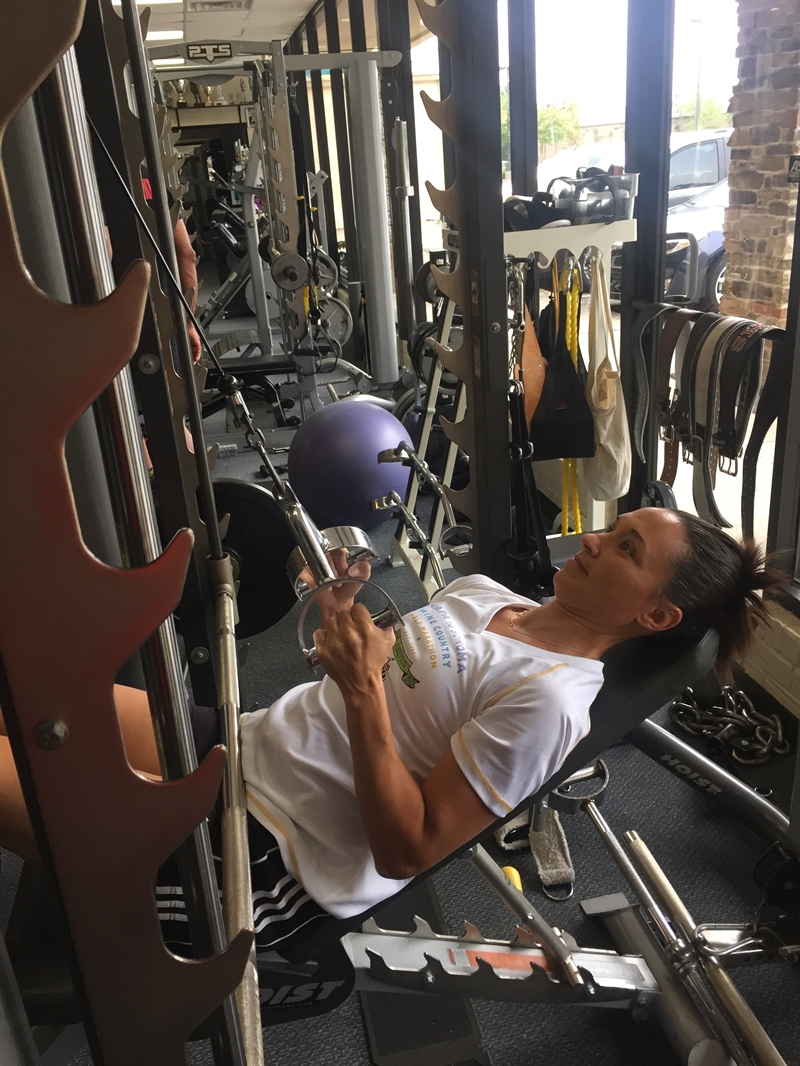
Figure 5: Isolated rows
This exercise works the latissimus dorsi, rhomboids, trapezius, and posterior deltoids, as well as the arm and chest muscles. Rowing in this position on an incline bench using a weighted bar to stabilize the hips isolates the muscles while supporting and protecting the back. Be sure to keep elbows close to the body as the arms pull the handles toward the chest. Perform three sets of 15 reps, increasing weight as needed.
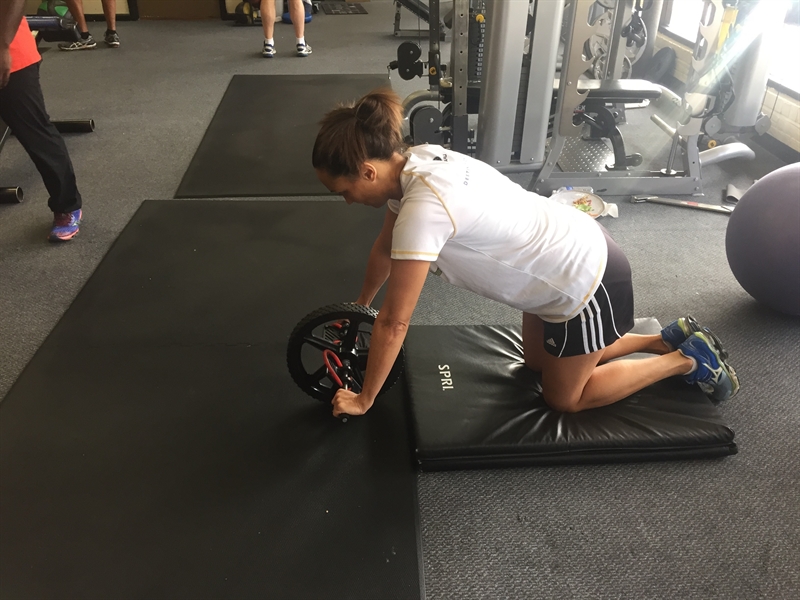
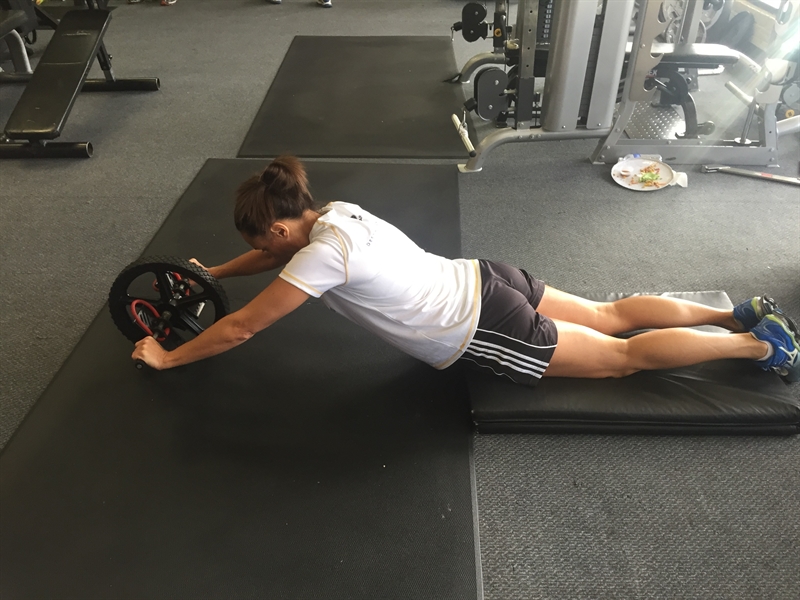
Figure 6: Ab wheel roll-out
Using a large exercise wheel on a folded mat (elevated about two to four inches off of the floor), this strengthens the back, lats, shoulders, and abdominals. Begin in the kneeling position with hands on the wheel handles and slowly extend straight out until thighs are touching the mat. Use abdominals, hip flexors, and hamstrings to initiate the pull back to the starting position and flex from the hips, keeping the shoulders flexed, arms extended, and back straight, similar to the drive phase. Perform three sets of 10-20 reps. Stop if the back begins to round; movement should come from the hip joint just as in the rowing stroke.
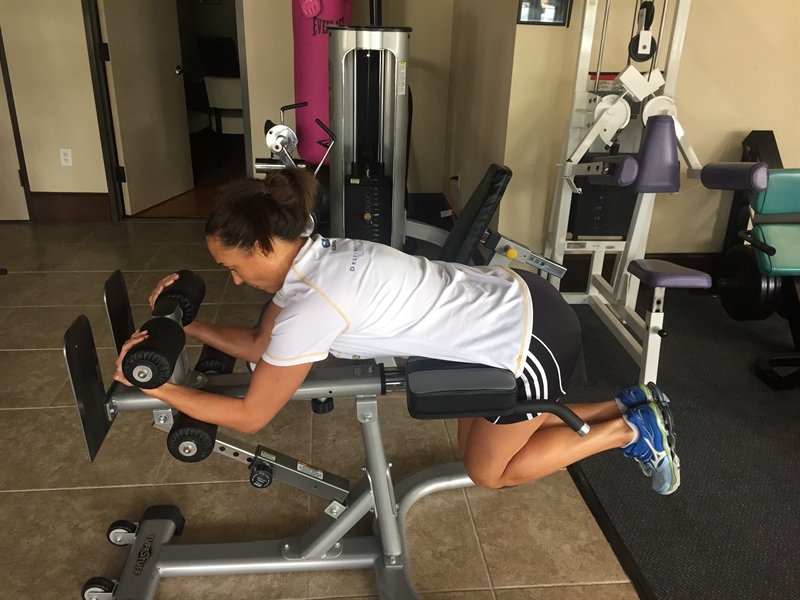
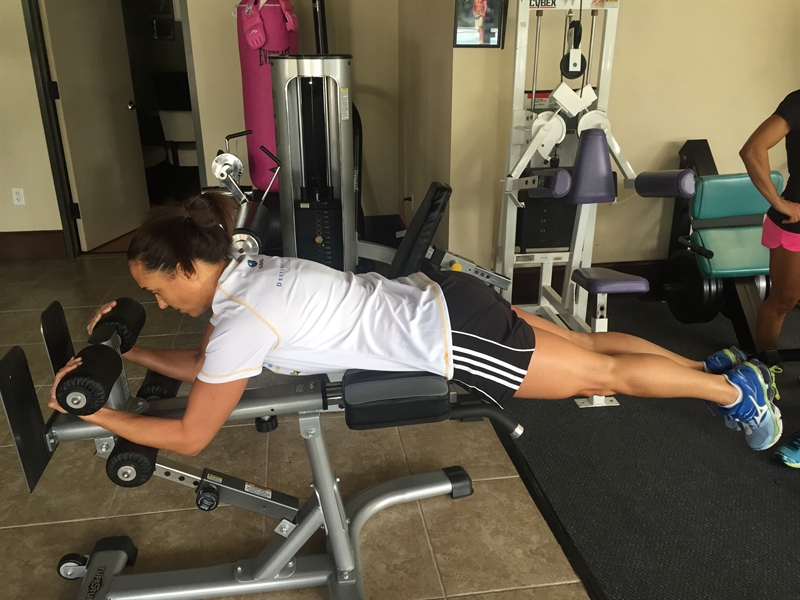
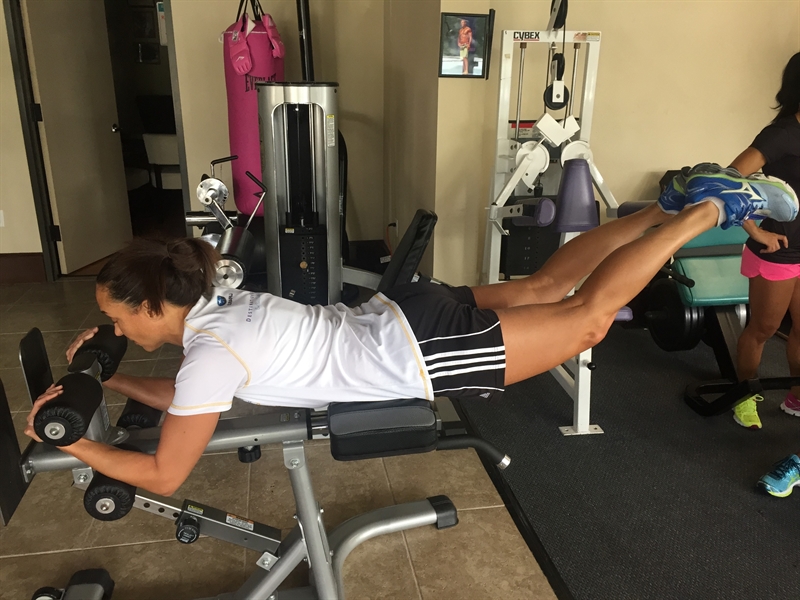
Figure 7: Reverse hyperextension
Isolate the low back paraspinals and gluts using a reverse hyperextension exercise. Stabilize the trunk in a prone on a bench and begin with the hips in a tucked position. Extend legs straight out, then extend hips, keeping pelvis and lower back on the bench. Return to the starting position. The movement should be controlled and purposeful, not using a swinging momentum but executing each part slowly. This exercise mimics the rowing stroke yet stabilizes and protects the low back. Perform three sets of 20 reps, progressing to 30 reps and adding ankle weights if needed.
Merrily, Merrily, Merrily: Eliminating Risk Factors for Injury
Since the primary mechanism for low back injuries in rowing is the powerful forces transmitted through the spine, decreasing risk of injury means either reinforcing the back to withstand the forces or decreasing the forces.
The spine is better able to endure the forces of rowing when it is straight and strong. A specific training program to increase strength and endurance of the muscles of the spine will contribute to a better rowing posture. A regular habit of dynamic stretching of the lower extremities and trunk prior to rowing will loosen and prepare muscles to attain the range needed so that the spine will not have to compensate for tightness.
Respiratory muscles also contribute to postural stability through increasing IAP. Training the respiratory muscles using an interval approach while running, biking or swimming helps them more easily handle intense bouts of exercise. A well-conditioned respiratory system will be able to handle both the challenges of breathing and postural support. In addition, athletes should breathe correctly, expiring during the drive, to take full advantage of the IAP’s role in alleviating the strain on the low back.
Interestingly, evaluation of the forces on the oar reveals that forces decrease as stroke rate increases(1). Since the compressive and sheer forces on the spine are directly proportional to the force exerted upon the oar, the load placed upon the spine also decreases with a faster stroke rate. This means a faster rowing cadence may also help decrease the risk of low back injury.
The time of day may also contribute to the vulnerability for injury. Overnight, the load on the spine is relieved and the intervertebral discs absorb fluid from surrounding tissues. Most rowing teams practice in the morning when intervertebral discs are plumper. Some researchers have suggested that the discs, when exposed to abnormal forces, such as when hyper flexed while rowing, are less able to withstand the forces during the morning hours when they are swollen than later in the day when they are compressed(7).
Living the Dream: Rowing Without Back Pain
Training the muscles of the back and shoulder is paramount to preventing low back injuries in rowing. However, ergometer training longer than 30 minutes correlates with low back pain. Therefore, the ergometer or water trainer should only be used for technique and aerobic work, not for strengthening(1). Above are a few sport-specific exercises that protect the back while strengthening the key muscles for rowing.
References
- Sports Health. 2012 May;4(3):236-45
- Asian J Sports Med.2014 Dec;5(4):e24293
- Int J Sports Med. 2000 Oct;21(7):518-23
- Physiotherapy. 1995 Feb;81(2):12-19
- J Sports Med Phys Fitness. 2000;40(3):223-32
- Am J Sports Med. 1984 Jul;12(4):278-82
- Sports Med. 2005;35(6):537-55
Newsletter Sign Up
Subscriber Testimonials
Dr. Alexandra Fandetti-Robin, Back & Body Chiropractic
Elspeth Cowell MSCh DpodM SRCh HCPC reg
William Hunter, Nuffield Health
Newsletter Sign Up
Coaches Testimonials
Dr. Alexandra Fandetti-Robin, Back & Body Chiropractic
Elspeth Cowell MSCh DpodM SRCh HCPC reg
William Hunter, Nuffield Health
Be at the leading edge of sports injury management
Our international team of qualified experts (see above) spend hours poring over scores of technical journals and medical papers that even the most interested professionals don't have time to read.
For 17 years, we've helped hard-working physiotherapists and sports professionals like you, overwhelmed by the vast amount of new research, bring science to their treatment. Sports Injury Bulletin is the ideal resource for practitioners too busy to cull through all the monthly journals to find meaningful and applicable studies.
*includes 3 coaching manuals
Get Inspired
All the latest techniques and approaches
Sports Injury Bulletin brings together a worldwide panel of experts – including physiotherapists, doctors, researchers and sports scientists. Together we deliver everything you need to help your clients avoid – or recover as quickly as possible from – injuries.
We strip away the scientific jargon and deliver you easy-to-follow training exercises, nutrition tips, psychological strategies and recovery programmes and exercises in plain English.
